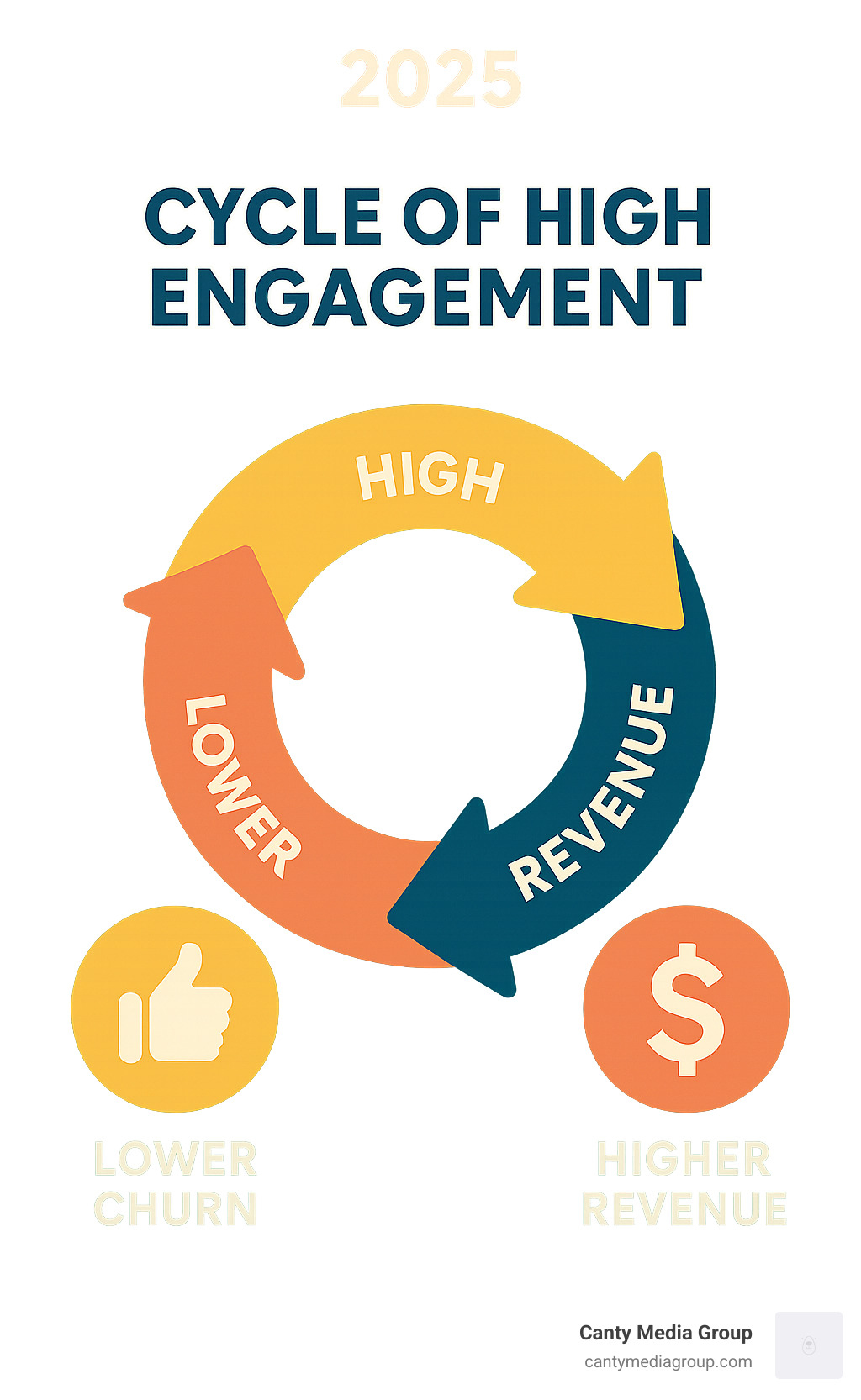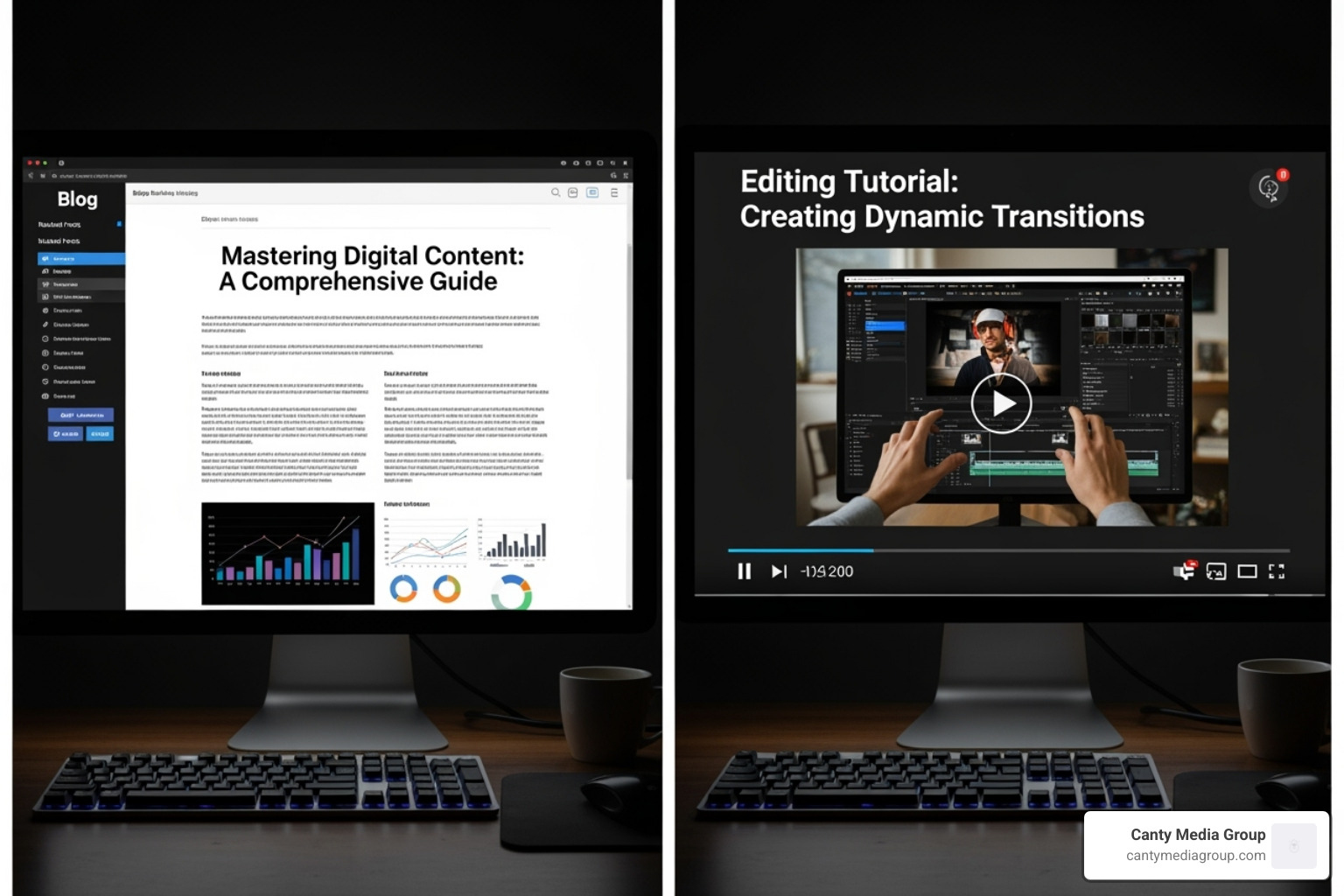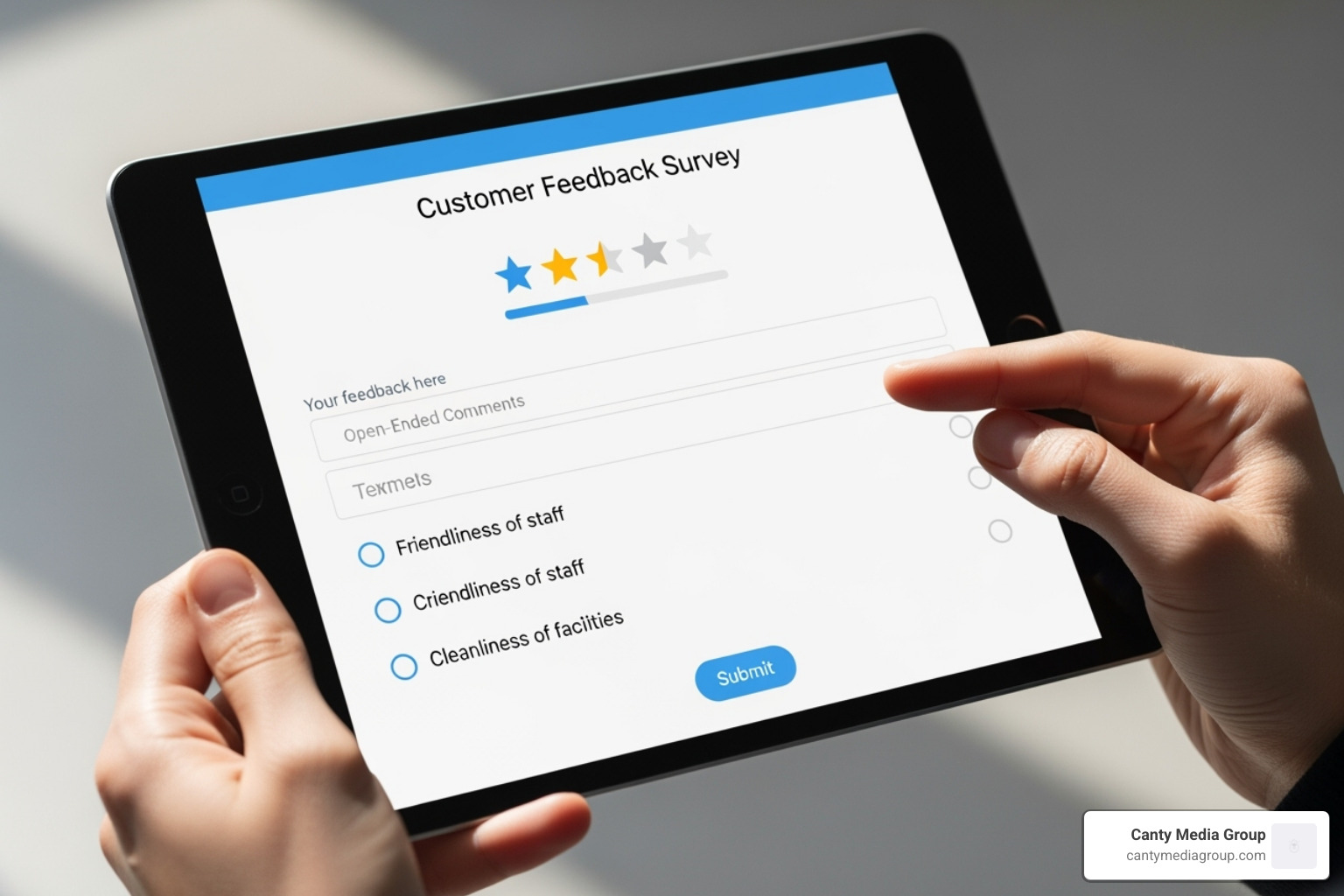Why Low Customer Engagement Is Killing Your Business
Low customer engagement is a major threat to business growth. If customers don’t interact with your brand, they’ll soon turn to a competitor.
Here are the main drivers and impacts:
Primary Drivers:
- Lack of value proposition – customers don’t see why they need your product
- Poor user experience – difficult websites, slow loading, confusing navigation
- Insufficient personalization – generic messaging that doesn’t resonate
- Inadequate communication – inconsistent or irrelevant outreach
- Ignoring customer feedback – not listening to what customers actually want
Business Impact:
- Revenue loss – engaged customers bring 23% more revenue than average customers
- Higher churn rates – roughly 50% of customers switch after one bad experience
- Increased acquisition costs – it costs 5-7 times more to acquire new customers than retain existing ones
The stakes are high. Improving engagement can boost cross-sell revenue by 22% and upsell revenue by 38%. Conversely, 76% of consumers get frustrated by a lack of personalization, which 71% now expect.
The good news? Customer engagement is fixable. The right strategies can turn disengaged users into loyal brand advocates.
I’m Ellisia R. Canty, and I’ve helped hundreds of small businesses build stronger customer relationships through digital marketing. I know what it takes to fix low customer engagement and drive measurable growth.

What Drives Low Customer Engagement?
Low customer engagement rarely stems from a single issue. It’s usually a combination of problems—like a weak value proposition, poor user experience (UX), and generic messaging—that make customers feel undervalued or forgotten.
A Weak Value Proposition
Even great products fail if customers don’t understand their value. Your value proposition is your promise: how you solve their problems better than the competition. A weak or unclear proposition leads to disinterest.
It starts with understanding customer needs and pain points. If you don’t address their specific problems, your solution feels irrelevant. Competitive analysis is also crucial; if your offering isn’t distinct, customers have no reason to stay. Finally, you must communicate value clearly, focusing on benefits, not just features. A fundamental product-market fit problem—a disconnect between your offer and customer wants—requires ongoing refinement based on real feedback.
From Poor User Experience to Low Customer Engagement
A frustrating website experience is a fast way to kill customer engagement. It creates friction and tells customers you don’t value their time.
- Website navigation problems, like a cluttered or confusing structure, tell customers to shop elsewhere.
- Page load speed is critical. Slow websites drive customers to competitors who respect their time.
- Mobile responsiveness is no longer optional. A site that works poorly on mobile appears unprofessional.
- Complicated checkout processes with too many steps or hidden fees lead to abandoned carts.
- Inaccessible support signals that you don’t value their business.
The Impact of Insufficient Personalization
In today’s crowded digital space, generic messaging is invisible. Customers are bombarded with information and will tune out irrelevant communications.
Generic messaging makes customers feel like a number. Sending the same email to everyone, regardless of their history or behavior, is a surefire way to be ignored. Irrelevant offers, like promoting products they just bought, can damage the relationship.
The solution is using customer data and smart segmentation. Understanding purchase history, browsing behavior, and preferences allows you to tailor interactions. This matters because 71% of consumers expect personalization, and 76% get frustrated when it doesn’t happen. Getting it right makes customers feel valued and understood, turning them into active participants in your brand story.
The High Cost of Disengagement: Why Churn Matters
Low customer engagement directly translates to higher customer churn, which can kill a business.

It’s like trying to fill a leaky bucket; you lose customers as fast as you acquire new ones, making growth impossible.
When customers disengage, the resources invested in acquiring them are lost.
- Revenue takes the biggest hit. Disengaged customers mean lost recurring income. In contrast, engaged customers bring 23% more revenue because they buy more and spend more.
- Brand reputation suffers. A staggering 80% of customers switch after bad experiences, and they often share their negative experiences online, warning others away.
- Customer acquisition costs skyrocket. Instead of growing your customer base, you’re stuck on a hamster wheel, constantly replacing those who left.
- Customer lifetime value (CLV) plummets. Disengaged customers have shorter relationships and spend less. Research shows that increasing retention by just 5% can boost profits by 25% because loyal customers buy more and refer others.
Low customer engagement creates a vicious cycle. The good news is that engagement is within your control, and small improvements can dramatically reduce churn.
13 Actionable Strategies to Boost Customer Engagement
Now, let’s fix low customer engagement. Here are 13 proven strategies to turn disengaged customers into loyal advocates. You don’t need to implement them all at once; start with a few that fit your business.
1. Personalize Every Interaction
Personalization is what 71% of consumers expect. Go beyond using a first name.
- Segment customers based on behavior, purchase history, or interests to tailor your messaging.
- Use behavioral data to create custom recommendations that feel insightful.
- Send personalized emails like abandoned cart reminders, birthday offers, or re-engagement campaigns.
2. Lift Your Customer Support
Great support makes customers feel heard and valued.
- Offer omnichannel support (email, live chat, phone, social media) for a consistent experience.
- Provide self-service options like a knowledge base or FAQs. 91% of consumers prefer using a knowledge base when available.
- Use proactive support to spot potential issues and reach out first. Since 96% of customers say excellent service is key to their loyalty, a well-trained, empathetic team is crucial.
3. Leverage Content Marketing
Content marketing keeps existing customers engaged by providing consistent value.

- Create educational content like how-to guides and success stories.
- Host interactive webinars on product tips or industry trends.
- Focus on helping, not selling, to build trust and loyalty.
4. Build a Thriving Community
A community transforms individual customers into a supportive network.
- Use online forums or social media groups for questions and conversations.
- Encourage and reshare user-generated content to provide social proof.
- Host virtual or in-person events to strengthen emotional connections.
5. Master High-Touch vs. Low-Touch Models
Not every customer needs the same level of attention.
- High-touch engagement (dedicated account managers, custom onboarding) is for high-value clients.
- Low-touch engagement (automated emails, in-app guidance) is for simpler products or independent customers.
- Tech-touch automation uses AI to provide personalized experiences at scale.
Segment customers by revenue or complexity to apply the right model.
6. Addressing Low Customer Engagement by Acting on Feedback
Customers disengage when they feel their opinions don’t matter.

- Regularly use surveys (NPS, CSAT) and monitor reviews.
- Close the loop: thank customers for feedback, explain your actions, and follow up. When customers see their ideas implemented, they feel like partners.
7. Consistent & Personal Communication (Beyond Personalization)
Sporadic or overwhelming outreach creates noise.
- Define clear communication goals and frequency to be helpful, not annoying.
- Use appropriate channels where your customers are active (email, social media, in-app messages).
- Ensure every communication provides genuine value. Quick, helpful responses are key—75% of customers expect social media responses within five minutes.
8. Gamify the Customer Journey
Game-like elements make interactions fun and rewarding.
- Award points and rewards for actions like purchases or referrals.
- Use leaderboards, badges, and challenges to encourage exploration and friendly competition.
- Gamification taps into our desire for achievement, turning routine tasks into engaging experiences.
9. Proactive Onboarding and Education
A strong onboarding process turns new customers into successful users.
- Use onboarding checklists to guide users through setup.
- Send a welcome email series to introduce key features and support options.
- Build product-led content like tutorials and tooltips directly into your platform.
10. Implement Loyalty Programs
Loyalty programs give customers tangible reasons to choose you.
- Use points-based systems or tiered programs that offer increasing benefits.
- Provide exclusive access or referral rewards to top customers.
- Keep the program valuable but simple to understand.
11. Use Predictive Analytics
Anticipate customer needs instead of reacting to problems.
- Integrate data from all touchpoints to build comprehensive customer profiles.
- Use machine learning to identify churn risks and upsell opportunities.
- Trigger automated interventions like targeted offers or proactive support.
12. Optimize Pricing & Offer Subscriptions
Convenience and cost can impact engagement.
- Analyze data to set optimal pricing tiers.
- Offer subscription models for convenience and predictable revenue.
- Send replenishment reminders to drive repeat business.
13. Monitor Engagement & Iteratively Improve
Customer engagement requires ongoing adaptation.
- Constantly monitor customer interactions with analytics tools.
- A/B test messaging, channels, and offers to see what resonates.
- Iterate based on data and invest in engagement tools to ensure your strategies remain effective.
How to Measure Customer Engagement: Key Metrics to Track
To fix low customer engagement, you must measure it. Tracking the right metrics is essential to understand how customers feel about your brand and whether your strategies are working.
These metrics provide a health check for your business. Here are the key ones to track:
- Daily/Monthly Active Users (DAU/MAU): These foundational metrics show how many unique people interact with your business daily and monthly. The Stickiness Ratio (DAU divided by MAU) reveals how often they return.
- Customer Lifetime Value (CLV): This is the total revenue you can expect from a customer. As engagement improves, CLV should increase.
- Net Promoter Score (NPS): This measures loyalty by asking how likely customers are to recommend you. It’s a powerful indicator of customer sentiment.
- Churn Rate: This is the percentage of customers who stop using your service. For SaaS companies, a good annual churn rate is 3% to 7%. A high rate signals serious engagement problems.
- Repeat Purchase Rate: This shows the percentage of customers who buy more than once, directly reflecting their satisfaction and value perception.
- Average Order Value (AOV): Engaged customers often spend more per transaction, so a rising AOV is a positive sign.
- Engagement Rate: For content, this measures audience interactions (likes, comments, shares) relative to your reach.
| Metric | Formula | What It Indicates |
|---|---|---|
| Daily Active Users (DAU) | Number of unique users per day | How many people engage with your business daily – indicates product stickiness |
| Monthly Active Users (MAU) | Number of unique users per month | Broader view of your engaged audience over time |
| Stickiness Ratio | (DAU / MAU) × 100 | Percentage of monthly users who engage daily – higher is better |
| Customer Lifetime Value (CLV) | Average purchase value × Average purchase frequency × Average customer lifespan | Total predicted revenue per customer – engaged customers have higher CLV |
| Net Promoter Score (NPS) | % Promoters – % Detractors | Customer loyalty and willingness to recommend your brand |
| Churn Rate | (Lost customers / Total customers at start) × 100 | Percentage who stopped using your service – lower indicates better engagement |
| Repeat Purchase Rate | (Repeat customers / Total customers) × 100 | Shows customer satisfaction and likelihood to return |
| Average Order Value (AOV) | Total revenue / Number of orders | Average spend per order – engaged customers often spend more |
| Engagement Rate | Interactions / Reach × 100 | How actively your audience interacts with your content |
Track these metrics over time to see trends. This will reveal if your efforts to combat low customer engagement are paying off.
Frequently Asked Questions about Customer Engagement
Here are answers to common questions I hear from business owners about customer engagement.
What is the difference between customer engagement and customer satisfaction?
These terms are often confused but measure different things.
Customer satisfaction is transactional. It measures happiness with a specific interaction or purchase—did the product meet expectations? Think of it as a report card for a single moment.
Customer engagement, on the other hand, is relational. It’s the ongoing, emotional connection a customer has with your brand. Engaged customers don’t just buy from you; they interact, advocate, and feel part of your community. For example, a customer can be satisfied with their coffee but not engaged with the shop. An engaged customer follows the shop on social media and knows the barista’s name.
The research shows that while 50% of customers report being satisfied, only 38% are engaged. Engagement is what drives long-term loyalty.
At Canty Media Group, we help businesses bridge that gap because engaged customers are the ones who truly transform your business.
How does improving customer engagement impact sales?
Improved engagement directly boosts your bottom line.
- Engaged customers spend more. They are more open to recommendations, leading to a 22% increase in cross-sell revenue and a 38% increase in upsell revenue.
- They place larger orders. Engagement can increase order size by 5% to 85%.
- They become repeat buyers. Returning customers are incredibly valuable; in the US, they are only 8% of visitors but generate 40% of total revenue.
- They become brand advocates. They provide powerful, cost-effective word-of-mouth marketing by leaving positive reviews and recommending you to friends.
What are the first steps to fix low customer engagement?
If you’re dealing with low customer engagement, it’s fixable. Approach it strategically.
- Do your homework. Before contacting a disengaged customer, review their history. Understand their original goals and pain points to show you respect their time.
- Focus on the relationship, not a sale. Ask open-ended questions to understand where the disconnect happened. For example, “Is our product working the way you envisioned?”
- Find quick wins. Demonstrate immediate value. Maybe they need a short training session on a feature that could solve a current problem. Rebuild trust through helpful actions.
- Make it about their success. Shift your focus from your metrics (like usage or renewals) to helping them achieve their goals. When they succeed, engagement naturally follows.
Fixing low customer engagement is a marathon, not a sprint, but the re-engaged customers often become your most loyal advocates.
Conclusion
Low customer engagement isn’t a death sentence—it’s a fixable problem. The solution is entirely within your control and lies in a customer-centric approach.
We’ve covered the causes of disengagement and provided 13 actionable strategies to turn things around. By combining approaches like personalization, community building, and acting on feedback, you can create a data-driven system that puts customer success first.
The results are tangible. Engaged customers bring 23% more revenue, and increasing retention by just 5% can boost profits by 25%. Tracking metrics like NPS and churn rate (aiming for a 3-7% SaaS benchmark) will prove your efforts are working.
Here in South Florida, from Belle Glade to Arcadia and everywhere in between, we’ve seen businesses transform when they prioritize customer engagement. It’s about building something sustainable that grows because people want to be part of your brand.
At Canty Media Group, we handle all the digital “background work” so you can focus on what you do best—running your business and serving your customers. Our direct, results-oriented approach means we’re not just talking about engagement strategies; we’re implementing them and measuring the results.
Ready to stop losing customers to disengagement? Let’s work together to turn your biggest challenge into your competitive advantage. Develop your digital marketing strategy with us and watch what happens when your customers become your biggest fans.